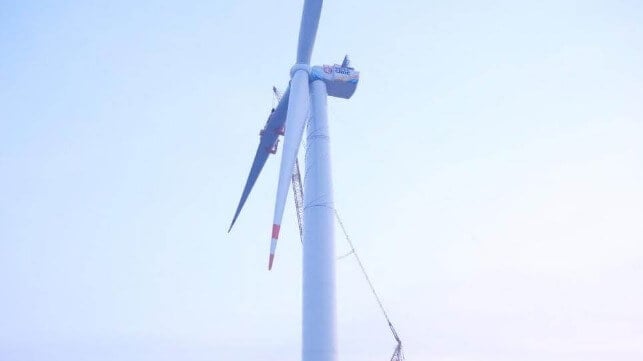China Says 20MW World’s Largest Floating Wind Turbine was Hoisted for Tests

A new 20 MW wind turbine designed for floating applications was recently successfully hoisted in China ahead of the start of testing. The state-owned company CRRC is calling the new unit the world's largest power-class floating wind turbine and an important step in the exploration of ultra-large offshore wind turbines.
The "Qihang" is a 20MW floating offshore wind turbine independently developed by CRRC. The unit rolled off the production line in Sheyang, Jiangsu in October 2024, and departed from Sheyang Port to Guangli Port in Dongying in mid-December. It was transferred to the Shandong Dongying Wind Power Equipment Testing and Certification Innovation Base test site using a self-propelled modular transport unit and on January 11, was successfully hoisted into position for testing.
The company reports the design has reached 20MW, which exceeds Envision Energy’s 16.7 MW prototype and Dongfang Electric’s 18 MW prototype, which both reported began testing in June 2024. However, China’s Mingyang Wind Power is working on an even larger 22 MW unit expected to be completed this year.
China seeks to dominate the offshore wind sector and has already surpassed the UK to have the largest installed base. The companies are working to break into the international market and become a supplier to European projects.
The new unit is massive in scale. CRRC reports the diameter of the wind rotor has reached 260 meters (853 feet), which it says is equivalent to seven standard football fields. The hub height is 151 meters (495 feet). The massive blades it reports have a tip speed "in line" with the speed of high-speed rail. Each rotation of the unit it says can meet the electricity demand of a family for 2 to 4 days, saving about 25,000 tons of coal consumption and reducing carbon dioxide emissions by about 62,000 tons per year.
The "Qihang" reportedly integrates cutting-edge innovative control technologies to ensure that the floating unit maintains extreme stability and minimal swing during operation. It adopts multiple typhoon-resistant technologies and strategies. It is also designed to take into account the reusability and scalability of some components and further improves the flexibility and efficiency of the unit through the modular construction of key system interfaces and structural parts.
To assess the changeable wind, wave, and current conditions at sea, the unit is planned to have more than 200 test points, covering blades, frames, transmission chains, towers, floats, and mooring systems. It will be collecting three-dimensional wind conditions, waves, 6-DOF floating platforms, and the response curves of each test point of the unit.
After completing the relevant tests and certifications, the unit will be put into deep-sea areas for grid-connected power generation.
